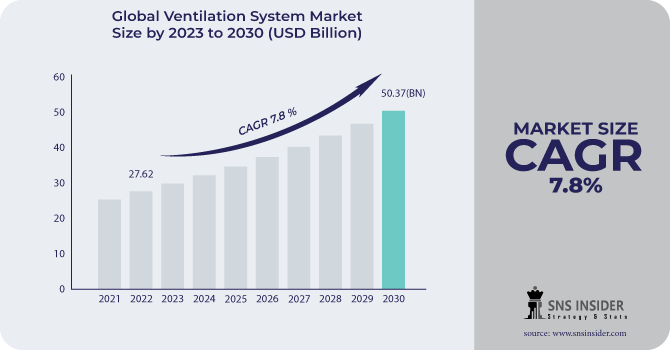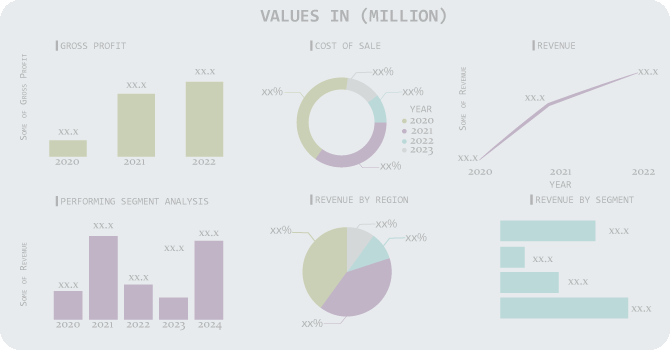Ventilation System Market Scope & Overview:
The Ventilation System Market size was USD 29.74 billion in 2023 and is expected to reach USD 53.84 billion by 2031 and grow at a CAGR of 7.7% over the forecast period of 2024-2031.
By exchanging outside and interior air, ventilation systems increase interior air quality (IAQ), which aids in the enhancement of the indoor environment. Indoor air-quality ventilation is useful for controlling thermal comfort when weather conditions change.

To get more information on Ventilation System Market - Request Free Sample Report
Recent advancements in fan technology, evaporative cooling, and control are proving to have substantial advantages over older systems. Rising technical improvements combined with ventilators are boosting the whole system's usability, efficiency, and efficacy. Heat recovery ventilators, air filters, and other products are being improved by leading manufacturers with programmable controls and technological developments to support simplified operations.
The present trend in the construction industry toward zero-energy buildings is projected to accelerate the ventilation system. Market expansion in the next few years. Various government entities, including 26 nations in the 'Energy in Building and Communities' report, promote the concept of green buildings. Governments are taking steps to build green infrastructure. Buildings and regulations addressing carbon emissions for residential and commercial purposes
MARKET DYNAMICS
KEY DRIVERS
-
Air Quality in the Home Concerns about the importance of indoor air quality (IAQ) and the health advantages of well-ventilated environments are key motivators. People are becoming increasingly aware of the importance of appropriate ventilation in removing pollutants and allergies.
-
Energy Conservation The increased emphasis on energy-efficient buildings, as well as the need to minimize energy consumption in HVAC systems, promote the development of innovative ventilation technologies capable of providing enough airflow while consuming the least amount of energy.
RESTRAIN
-
Initial Investment Installation costs for sophisticated ventilation systems, particularly those with high-efficiency filters and sensors, can be rather pricey, which may dissuade some clients.
-
Regular maintenance is required for ventilation systems to perform properly, and this can contribute to the overall cost of ownership.
-
Technical Difficulties Effective ventilation systems may be hard to design and install, and ensuring that they satisfy all regulatory standards can be difficult.
OPPORTUNITY
-
Technological Advances Continuous developments in ventilation technology, such as the development of energy-efficient fans, smart controls, and air purification systems, generate market growth potential.
-
The need to replace existing buildings with better ventilation systems creates considerable business potential, particularly in metropolitan locations with older infrastructure.
CHALLENGES
-
Market Competence The ventilation system market is crowded, with many companies offering a diverse variety of goods. Companies may find it difficult to differentiate themselves due to competition.
-
Changing laws Changing building codes and ventilation laws can make it difficult for manufacturers and installers to remain up-to-date with the current requirements.
IMPACT OF RUSSIA-UKRAINE WAR
Demand fluctuations, anxiety, and project delays Geopolitical tensions and economic insecurity can cause corporate anxiety. This uncertainty may lead to building project delays or cancellations, affecting demand for ventilation systems in the commercial and residential sectors. Impact of Research and Development on Innovation and Market Growth Geopolitical conflicts can siphon resources away from R&D initiatives in impacted countries. This might hinder the commercial launch of novel ventilation methods. Changes in the regulatory environment can lead to changes in trade agreements and regulations, which can influence product standards and import/export processes for ventilation systems.
IMPACT OF ONGOING RECESSION
Building owners and homeowners may postpone restoration and upgrading projects due to budget restrictions during economic downturns. This delay may have an impact on ventilation system replacement or installation. During a recession, the commercial sector, which includes retail stores, offices, and restaurants, may see lower foot traffic and occupancy. As a result, companies may be less willing to replace their ventilation systems. Cost-conscious consumers and organizations may choose less costly HVAC and ventilation solutions or postpone maintenance and replacement of current systems, reducing sales of high-end ventilation goods.
KEY MARKET SEGMENTATION
By Product Type
-
Data Center Cooling
-
In row cooling
-
Fan Wall
-
Precise air conditioner
-
-
Centralized ventilation
-
Fresh Air System
-
AHU
-
-
Decentralized ventilation
-
Bath Fan
-
Single tunnel fresh air ventilation
-
-
Range hood
-
Hood
-
Downdraft
-
Rooftop
-
By Application
-
Commercial
-
Data Center Cooling
-
Centralized ventilation
-
Decentralized ventilation
-
Range hood
-
-
Residential
-
Centralized ventilation
-
Decentralized ventilation
-
Range hood
-
-
Industrial
-
Centralized ventilation
-
Decentralized ventilation
.png)
Need any customization research on Ventilation System Market - Enquiry Now
Region Coverage
North America
-
USA
-
Canada
-
Mexico
Europe
-
Eastern Europe
-
Poland
-
Romania
-
Hungary
-
Turkey
-
Rest of Eastern Europe
-
-
Western Europe
-
Germany
-
France
-
UK
-
Italy
-
Spain
-
Netherlands
-
Switzerland
-
Austria
-
Rest of Western Europe
-
Asia Pacific
-
China
-
India
-
Japan
-
South Korea
-
Vietnam
-
Singapore
-
Australia
-
Rest of Asia Pacific
Middle East & Africa
-
Middle East
-
UAE
-
Egypt
-
Saudi Arabia
-
Qatar
-
Rest of the Middle East
-
-
Africa
-
Nigeria
-
South Africa
-
Rest of Africa
-
Latin America
-
Brazil
-
Argentina
-
Colombia
-
Rest of Latin America
REGIONAL ANALYSIS
In 2022, the Asia-Pacific market was estimated to be worth USD 11.29 billion. The region is predicted to have the greatest market share as growing economies such as India, South Korea, China, and Japan become more appealing as air handling systems and tunnel fresh air ventilation become more prevalent in residential, commercial, and industrial areas. Because of expanding urbanization and end-user disposable income, emerging countries such as China have become appealing.
Three nations are expected to dominate the Asia-Pacific market: China, Japan, and South Korea. This is attributable to rising disposable income, stable economic circumstances, and government investment in new residential and commercial buildings, which require more ventilation systems to enhance indoor air quality.
North America is expected to develop at a steady pace throughout the forecast period due to increased demand for residential indoor air quality systems caused by extreme weather conditions such as heavy snowfall, hailstorms, hurricanes, and others. Rising home investment would increase the need for these systems to provide a safe and healthy indoor environment throughout the region.
KEY PLAYERS
The major key players are Midea Group Co., Ltd., KOMFOVENT, CaptiveAire Systems, Greenheck Fan Corporation, S&P UK Ventilation Systems Ltd., Twin City Fan & Blower, Honeywell International Inc., CENTROTEC SE, Johnson Controls, Mitsubishi Electric Corporation and Other Players
Midea Group Co Ltd-Company Financial Analysis

RECENT DEVELOPMENTS
Abound Healthy Air Starter: In August 2022, Carrier began offering the Abound Healthy Air Starter Package to enhance indoor air quality by detecting and reacting to camouflage components in a rapid, easy, and cost-effective manner.
Johnson Controls: In May 2021, Johnson Controls finalized the acquisition of Silent-Aire for an estimated USD 0.8 billion. Silent-Aire is a global leader in modular critical infrastructure solutions and hyperscale data center cooling.
Midea Group: In April 2021, Midea Group displayed a variety of high-efficiency precision cabinet-type industrial precision fan coil units. The series debuted during the CRH-2021 (China Refrigeration and Heating 21) exhibition.
| Report Attributes | Details |
| Market Size in 2023 | US$ 29.74 Bn |
| Market Size by 2031 | US$ 53.84 Bn |
| CAGR | CAGR of 7.7% From 2024 to 2031 |
| Base Year | 2023 |
| Forecast Period | 2024-2031 |
| Historical Data | 2020-2022 |
| Report Scope & Coverage | Market Size, Segments Analysis, Competitive Landscape, Regional Analysis, DROC & SWOT Analysis, Forecast Outlook |
| Key Segments | • By Product Type (Data Center Cooling, row cooling, Fan Wall, Precise air conditioner, Centralized ventilation, Fresh Air System, AHU, Decentralized ventilation, Bath Fan, Single tunnel fresh air ventilation, Range hood, Hood, Downdraft, Rooftop) • By Application (Commercial, Data Center Cooling, Centralized ventilation, Decentralized ventilation, Range hood, Residential, Centralized ventilation, Decentralized ventilation, Range hood, Industrial, Data Center Cooling, Centralized ventilation, Decentralized ventilation) |
| Regional Analysis/Coverage | North America (US, Canada, Mexico), Europe (Eastern Europe [Poland, Romania, Hungary, Turkey, Rest of Eastern Europe] Western Europe] Germany, France, UK, Italy, Spain, Netherlands, Switzerland, Austria, Rest of Western Europe]), Asia Pacific (China, India, Japan, South Korea, Vietnam, Singapore, Australia, Rest of Asia Pacific), Middle East & Africa (Middle East [UAE, Egypt, Saudi Arabia, Qatar, Rest of Middle East], Africa [Nigeria, South Africa, Rest of Africa], Latin America (Brazil, Argentina, Colombia Rest of Latin America) |
| Company Profiles | Midea Group Co., Ltd., KOMFOVENT, CaptiveAire Systems, Greenheck Fan Corporation, S&P UK Ventilation Systems Ltd., Twin City Fan & Blower, Honeywell International Inc., CENTROTEC SE, Johnson Controls and Mitsubishi Electric Corporation |
| Key Drivers | • Air Quality in the Home Concerns about the importance of indoor air quality (IAQ) and the health advantages of well-ventilated environments are key motivators. People are becoming increasingly aware of the importance of appropriate ventilation in removing pollutants and allergies. • Energy Conservation The increased emphasis on energy-efficient buildings, as well as the need to minimize energy consumption in HVAC systems, promote the development of innovative ventilation technologies capable of providing enough airflow while consuming the least amount of energy. |
| Market Opportunity | • Technological Advances Continuous developments in ventilation technology, such as the development of energy-efficient fans, smart controls, and air purification systems, generate market growth potential. • The need to replace existing buildings with better ventilation systems creates considerable business potential, particularly in metropolitan locations with older infrastructure. |

